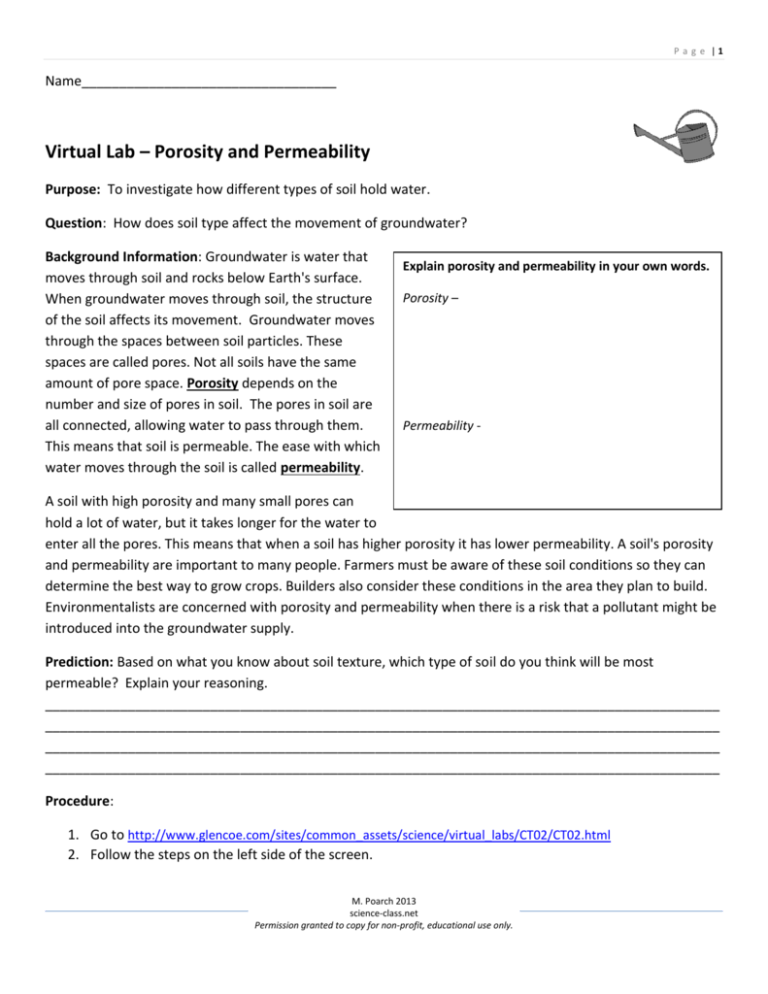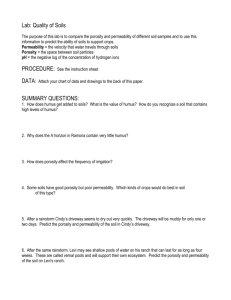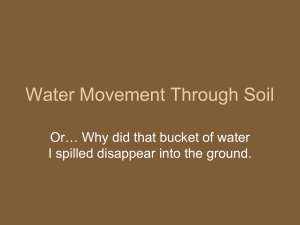Virtual Lab – Porosity and Permeability - Science
advertisement

P a g e |1 Name__________________________________ Virtual Lab – Porosity and Permeability Purpose: To investigate how different types of soil hold water. Question: How does soil type affect the movement of groundwater? Background Information: Groundwater is water that moves through soil and rocks below Earth's surface. When groundwater moves through soil, the structure of the soil affects its movement. Groundwater moves through the spaces between soil particles. These spaces are called pores. Not all soils have the same amount of pore space. Porosity depends on the number and size of pores in soil. The pores in soil are all connected, allowing water to pass through them. This means that soil is permeable. The ease with which water moves through the soil is called permeability. Explain porosity and permeability in your own words. Porosity – Permeability - A soil with high porosity and many small pores can hold a lot of water, but it takes longer for the water to enter all the pores. This means that when a soil has higher porosity it has lower permeability. A soil's porosity and permeability are important to many people. Farmers must be aware of these soil conditions so they can determine the best way to grow crops. Builders also consider these conditions in the area they plan to build. Environmentalists are concerned with porosity and permeability when there is a risk that a pollutant might be introduced into the groundwater supply. Prediction: Based on what you know about soil texture, which type of soil do you think will be most permeable? Explain your reasoning. __________________________________________________________________________________________ __________________________________________________________________________________________ __________________________________________________________________________________________ __________________________________________________________________________________________ Procedure: 1. Go to http://www.glencoe.com/sites/common_assets/science/virtual_labs/CT02/CT02.html 2. Follow the steps on the left side of the screen. M. Poarch 2013 science-class.net Permission granted to copy for non-profit, educational use only. P a g e |2 Data: Type of soil Amount of water held by soil 1 2 3 4 5 6 7 8 9 10 11 12 13 Questions: What determines the texture of soil? __________________________________________________________________________________________ __________________________________________________________________________________________ What is meant by the permeability of a soil? __________________________________________________________________________________________ __________________________________________________________________________________________ __________________________________________________________________________________________ What is porosity and how is it related to permeability? __________________________________________________________________________________________ __________________________________________________________________________________________ __________________________________________________________________________________________ M. Poarch 2013 science-class.net Permission granted to copy for non-profit, educational use only. P a g e |3 Based on this investigation, which type of soil is the most permeable? Which is the least permeable? How do you know? Support your statement with evidence. __________________________________________________________________________________________ __________________________________________________________________________________________ __________________________________________________________________________________________ __________________________________________________________________________________________ __________________________________________________________________________________________ Think about it: Explain why surface runoff, or rain not absorbed by the soil, occurs much more often in areas with soils with a high clay content. __________________________________________________________________________________________ __________________________________________________________________________________________ __________________________________________________________________________________________ __________________________________________________________________________________________ __________________________________________________________________________________________ Farmers often have problems with soil erosion when they clear their fields after the growing season. Soil type is one factor that influences erosion. Some soil types are more prone to erosion than others. Based on the data you gathered in this experiment, which soil types do you think are the most easily eroded, soils with a high sand content or soils with a high clay content? Explain your answer. __________________________________________________________________________________________ __________________________________________________________________________________________ __________________________________________________________________________________________ __________________________________________________________________________________________ __________________________________________________________________________________________ __________________________________________________________________________________________ __________________________________________________________________________________________ __________________________________________________________________________________________ __________________________________________________________________________________________ M. Poarch 2013 science-class.net Permission granted to copy for non-profit, educational use only.







